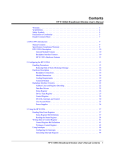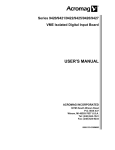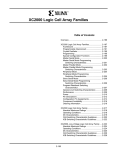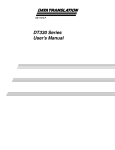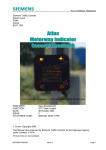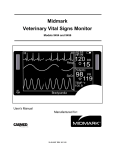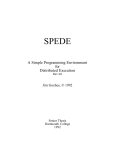Download Series 941X/946X Digital I/O Board USER`S MANUAL
Transcript
Series 941X/946X Digital I/O Board USER’S MANUAL ACROMAG INCORPORATED 30765 South Wixom Road P.O. BOX 437 Wixom, MI 48393-7037 U.S.A. Tel: (248) 624-1541 Fax: (248) 624-9234 8500-244-B97J006 AVME941X/946X DIGITAL I/O BOARDS _________________________________________________________________________________ The information in this manual is subject to change without notice. Acromag, Inc., makes no warranty of any kind with regard to this material, including, but not limited to, the implied warranties of merchantability and fitness for a particular purpose. Further, Acromag, Inc., assumes no responsibility for any errors that may appear in this manual and makes no commitment to update, nor keep current, the information contained in this manual. No part of this manual may be copied or reproduced in any form, or by any means, without the prior written consent of Acromag, Inc. IMPORTANT SAFETY CONSIDERATIONS It is very important for the user to consider the possible adverse effects of power, wiring, component, sensor or software failures in designing any type of control or monitoring system. This is especially important where economic property loss or human life is involved. It is important that the user employ redundancy, and comprehensive failure analysis to insure a safe and satisfactory overall system design. It is agreed between the Buyer and Acromag, that this is the Buyer's responsibility. Acromag, Inc. 30765 South Wixom Road P.O. Box 437 Wixom, Michigan 48393-7037, USA Tel: (248) 624-1541 Fax: (248) 624-9234 Copyright 1992, 1995 Acromag, Inc. Printed in USA Data and specifications subject to change without notice -1- AVME941X/946X DIGITAL I/O BOARDS _________________________________________________________________________________ TABLE OF CONTENTS CHAPTER 1.0 1.1 1.2 1.3 1.4 GENERAL INFORMATION...................................................................................................... INTRODUCTION...................................................................................................................... FEATURES OF THE AVME946X............................................................................................. FEATURES OF THE AVME941X............................................................................................. VMEbus INTERFACE FEATURES........................................................................................... Page 4 4 4 4 5 2.0 PREPARATION FOR USE....................................................................................................... 2.1 UNPACKING AND INSPECTION............................................................................................. 2.2 CARD CAGE CONSIDERATIONS........................................................................................... 2.3 BOARD CONFIGURATION...................................................................................................... 2.3.1 Default Jumper Configuration........................................................................................... 2.4 ADDRESS ASSIGNMENT........................................................................................................ 2.5 JUMPER AND OPTIONS......................................................................................................... 2.6 I/O CONNECTIONS................................................................................................................. 2.7 BACKPLANE REQUIREMENTS.............................................................................................. 2.8 USE WITH SOLID STATE RELAYS........................................................................................ 2.8.1 Configuring the AVME94XX............................................................................................. 2.8.2 Configuring the PB16A..................................................................................................... 2.9 USE WITH OTHER DEVICES................................................................................................. 2.9.1 Relays and Other Inductive Loads.................................................................................... 2.9.2 Contact Closures and Switches........................................................................................ 5 5 5 6 6 6 8 8 11 12 12 12 12 12 13 3.0 PROGRAMMING INFORMATION........................................................................................... 3.1 MEMORY MAP......................................................................................................................... 3.1.1 Board Identification PROM............................................................................................... 3.1.2 Board Status Register....................................................................................................... 3.1.3 Digital I/O Port Registers................................................................................................... 3.1.4 Digital Output Register...................................................................................................... 13 13 14 15 16 16 4.0 4.1 4.2 4.3 THEORY OF OPERATION....................................................................................................... VMEbus INTERFACE............................................................................................................... BOARD CONTROLLER........................................................................................................... DIGITAL PORT SECTION........................................................................................................ 16 16 16 16 5.0 5.1 5.2 5.3 SERVICE AND REPAIR INFORMATION................................................................................ SERVICE AND REPAIR ASSISTANCE................................................................................... PRELIMINARY SERVICE PROCEDURE................................................................................ PARTS LISTS........................................................................................................................... 17 17 17 17 6.0 SPECIFICATIONS.................................................................................................................... 19 -2- AVME941X/946X DIGITAL I/O BOARDS _________________________________________________________________________________ FIGURES: 2.1 2.2 2.3 2.4 2.5 2.6 2.7 2.8 4.1 4.2 AVME94XX JUMPER LOCATION DRAWING (4500-949)....................................................... 9921-16 CONNECTION DIAGRAM (4500-790)....................................................................... 9921-32 CONNECTION DIAGRAM (4500-791)....................................................................... AVME946X CONNECTION DIAGRAM (4500-950).................................................................. 9921-16 DIGITAL I/0 ADAPTER CARD (4500-788)................................................................. 9921-32 DIGITAL I/0 ADAPTER CARD (4500-789)................................................................. RELAY DRIVER CONFIGURATIONS (4500-743)................................................................... INPUT CONFIGURATIONS(4500-743).................................................................................... AVME946X/941X BLOCK DIAGRAM.(4500-948)...................................................................... SIMPLIFIED I/O POINT SCHEMATIC (4500-947).................................................................... 20 21 22 23 24 25 26 26 27 28 AVME946X/941X SCHEMATIC & PART LOCATION DRAWING (4500-946)......................... 29 -3- AVME941X/946X DIGITAL I/O BOARDS _________________________________________________________________________________ 1.0 GENERAL INFORMATION 1.1 INTRODUCTION This manual covers eight models of digitial boards. Table 1.1 lists the model numbers and their major differences. MODEL AVME9460 AVME9461 AVME9462 AVME9463 AVME9410 AVME9411 AVME9412 AVME9413 INTERACE POINTS 64 I/O 64 I/O 32 I/O 32 I/O 64 OUTPUTS 64 OUTPUTS 32 OUTOUTS 32 OUTPUTS FRONT PANEL ACCESS P3, P4, P5, P6 REAR ACCESS P2 P3, P4 P2 P3, P4, P5, P6 P2 P3, P4 P2 General Features The AVME946X Digital Input/Output (I/O) Board provides a means for interfacing various discrete devices to a VMEbus based computer. Interfacing is accomplished by 32 or 64 general purpose I/O points which under software control may be individually programmed to be inputs or outputs. 1.2 FEATURES OF THE AVME 946X • • • • • • • • • • • 32 or 64 programmable I/O points (lines) configured as 4 or 8 - 8 bit ports or 2 or 4 - 16 bit ports all with inverted logic. Can read the state of points configured as outputs. Outputs sink up to 100 mA, from an external 5V supply. Built in protection diodes for driving relay coils. Input hysteresis. Compatible with industry standard solid state relays and termination panels, PB16 and PB32. AVME 9460 and 9462 provide direct connection to the PB16 termination panel, no adapter boards necessary. Optional universal termination panel available for use with contact closures, relays, incandescent lamps. TTL and CMOS compatible. Byte or word data transfers. Board identification PROM. Pass/Fail Status indicators on the front panel. I/O accessible through the front panel or out of the back of the card cage. 1.3 FEATURES OF THE AVME 941X The AVME941X Digital Output Board provides a means for interfacing various discrete devices to a VMEbus based computer. Interfacing is accomplished by 32 or 64 output points. The AVME 941X Digital Output Board features: • • • 32 or 64 programmable Output points (lines) configured as 4 or 8 - 8 bit ports or 2 or 4 - 16 bit ports all with inverted logic. Outputs sink up to 100 mA, from up to a 30V external source. Built in protection diodes for driving relay coils. -4- AVME941X/946X DIGITAL I/O BOARDS _________________________________________________________________________________ Compatible with industry standard solid state relay termination panels, PB16 and PB32. AVME 9410 and 9412 provide direct connection to the PB16 termination panel, no adapter boards necessary. Optional universal termination panel available for use with contact closures, relays, incandescent lamps. • • • • • TTL and CMOS compatible. Byte or word data transfers. Board identification PROM. Pass/Fail Status indicators on the front panel. I/O accessible through the front panel or out of the back of the card cage. 1.4 VMEbus INTERFACE FEATURES • • • • • Slave module A24/A16, D16/D08 (EO). Short I/O Address Modifiers 29H, 2DH (H = Hex). Standard Address Modifiers 39H, 3DH (H = Hex). I(1-7) interrupter, jumper programmable interrupt level, software programmable interrupt vectors (for digital input channels 0-7), interrupt release mechanism is Release On Register Access (RORA) type. Decode on 1K byte boundaries. 2.0 PREPARATION FOR USE This chapter provides information about preparing the Isolated Digital I/O Board for system operation. 2.1 UNPACKING AND INSPECTION Inspect the shipping carton immediately upon receipt for evidence of mishandling during transit. If the shipping carton is severely damaged or water stained, request that the carrier's agent be present when the carton is opened. If the carrier's agent is absent when the carton is opened and the contents of the carton are damaged, keep the carton and packing material for the agent's inspection. For repairs to a product damaged in shipment, refer to the Acromag Service Policy to obtain return instructions. It is suggested that salvageable shipping cartons and packing material be saved for future use in the event the product must be shipped. The board is physically protected with foam and electrically protected with an antistatic bag during shipment. It is advisable to visually inspect the board for evidence of mishandling prior to applying power. CAUTION SENSITIVE ELECTRONIC DEVICES USE ANTI-STATIC HANDLING PROCEDURES 2.2 CARD CAGE CONSIDERATIONS Refer to the specifications for bus loading and power requirements. Be sure that the system power supplies are able to accommodate the additional requirements within the voltage tolerances specified. -5- AVME941X/946X DIGITAL I/O BOARDS _________________________________________________________________________________ Adequate air circulation must be provided to prevent a temperature rise above the maximum operating temperature. Large and continuing fluctuations in ambient air temperature should be avoided. If the installation is in an industrial environment and the board is exposed to environmental air, careful consideration should be given to air filtering. 2.3 BOARD CONFIGURATION The Digital I/O Board may be configured in a variety of ways for many different applications. Each possible jumper setting will be discussed in the following sections. The jumper locations are shown in Figure 2.1. 2.3.1 Default Jumper Configuration VMEBUS INTERFACE CONFIGURATION When a board is shipped from the factory, it is configured as follows: • • VMEbus Short I/O Address of 0000H. Set to respond to both Address Modifiers 2DH. 2.4 ADDRESS ASSIGNMENT Jumpers J17, J18, and J19 are used to establish the base address for the 1k byte block of memory the AVME 94XX will occupy in the Memory Map. J17 and J18 selects the base address. An open, or no jumper installed, corresponds to a logic 0 state. Refer to Table 2.2 Address Decoding. J19 selects the address modifier codes and the Standard or Short Memory Map. An open on J19 pins 1 and 2 selects only the Supervisory Access (3DH or 2DH) code. A short on J19 pins 1 and 2 will allow the card to recognize both the Supervisory and the NonPriviledged Access codes. An open, or no jumper installed, on J19 pins 3 and 4 selects Short Memory Map. A short, or jumper installed, selects Standard Memory Map. Refer to Table 2.1. Table 2.1 VMEbus Address Modifier Codes Jumper J19 Address Modifier Codes Recognized Pins 3&4 OUT OUT Pins 1&2 OUT IN 2DH 2DH OR 29H IN IN OUT IN 3DH 3DH OR 39H -6- Addressing Mode Short Supervisory Short Supervisory or Short Non-Priveledged Standard Supervisory Standard Supervisory or Standard Non-Priveledged AVME941X/946X DIGITAL I/O BOARDS _________________________________________________________________________________ Table 2.2 VMEbus Address Decoding Jumper J19 Pins 3 & 4 - No Jumper Installed - Selecting The Short Memory Map. J18 Has No Effect On The Base Address Selection. Pins of J17 BASE ADDR (HEX) 0000 0400 0800 . . . F400 F800 FC00 S15 (11 & 12) OUT OUT OUT . . . IN IN IN S14 (10 & 9) OUT OUT OUT . . . IN IN IN S13 (8 & 7) OUT OUT OUT . . . IN IN IN S12 (6 & 5) OUT OUT OUT . . . IN IN IN S11 (4 & 3) OUT OUT IN . . . OUT IN IN S10 (2 & 1) OUT IN OUT . . . IN OUT IN Pins of J18 BASE ADDR (HEX) 000000 010000 020000 030000 . . . FC0000 FD0000 FE0000 FF0000 S23 (15&16) OUT OUT OUT OUT . . . IN IN IN IN S22 (13&14) OUT OUT OUT OUT . . . IN IN IN IN S21 (11&12) OUT OUT OUT OUT . . . IN IN IN IN S20 (9&10) OUT OUT OUT OUT . . . IN IN IN IN -7- S19 (7&8) OUT OUT OUT OUT . . . IN IN IN IN S18 (5&6) OUT OUT OUT OUT . . . IN IN IN IN S17 (3&4) OUT OUT IN IN . . . OUT OUT IN IN S16 (1&2) OUT IN OUT IN . . . OUT IN OUT IN AVME941X/946X DIGITAL I/O BOARDS _________________________________________________________________________________ 2.5 JUMPERS AND OPTIONS Several jumpers have been included to allow for flexible interfacing to external devices. Table 2.3 describes the various jumpers and their functions. TABLE 2.3 Jumper Descriptions Jumper Function Condition as shipped J2 J4 J6 J10 Port pullup voltage jumper. When in placem pulls the I/O lines to +5V through the removable pullup networks. Jumpers in place J9 J7 J5 J15 J3 J13 J1 J11 Port N+0 output driver enable Port N+1 output driver enable Port N+2 output driver enable Port N+3 output driver enable Port N+4 output driver enable Port N+5 output driver enable Port N+6 output driver enable Port N+7 output driver enable J1-15 Odd. made with a thin trace on solder side. Cutting a jumper will disable that group of 8 ouputs. J1 - J15 Odd, are used only in cases where it is absolutely necessary to have outputs disabled through hardware. See section 3.5, Programming Considerations, for software enabling/disabling of outputs. 2.6 I/O CONNECTIONS On Model AVME94X1, the 64 I/O points are accessible through a 96 pin Din 41612 connector labeled P2. CAUTION DO NOT PLUG P2 INTO ANY BACKPLANES IN A CARD CAGE! I/O adapter cards (Model 9921-16 or 9921-32) are used to interface between P2 and the ribbon cables. These adapters mount to the back of a VME cage to provide the mating socket for P2. Refer to termination panel connection diagrams, figure 2.2 and 2.3. On Model AVME94X0, four 50-pin ribbon cable connectors (labeled P3, P4, P5 and P6) on the front panel are used to access the 64 I/O points. Refer to the termination panel connection diagram figure 2.4. Refer to Table 2.4 for the I/O Connector Pin Assignments. -8- AVME941X/946X DIGITAL I/O BOARDS _________________________________________________________________________________ Table 2.4 I/O Connectors P2, P3, P4, P5 & P6 Functions Port N+0 I/O Bit 7 6 5 4 3 2 1 0 Port N+1 I/O Bit 7 6 5 4 3 2 1 0 +5V GND GND Pullup Ports 0 & 1 Protect Ports 0 & 1 Port N+2 I/O Bit 7 6 5 4 3 2 1 0 Port N+3 I/O Bit 7 6 5 4 3 2 1 0 +5V GND GND Pullup Ports 2 & 3 Protect Ports 2 & 3 P2 Pin # B25 B26 B27 B28 B29 B30 B31 B32 B17 B18 B19 B20 B21 B22 B23 B24 B9 B13,B14 B15,B16 B11 B10 A25 A26 A27 A28 A29 A30 A31 A32 A17 A18 A19 A20 A21 A22 A23 A24 B1 B5,B6 B7,B8 B3 B2 -9- P3 Pin # P4 Pin # 33 35 37 39 41 43 45 47 17 19 21 23 25 27 29 31 1,49 2 thru 50 Even 5 3 6 4 33 35 37 39 41 43 45 47 17 19 21 23 25 27 29 31 1,49 2 thru 50 Even 5 3 AVME941X/946X DIGITAL I/O BOARDS _________________________________________________________________________________ Table 2.4 Continued Functions Port N+4 I/O Bit 7 6 5 4 3 2 1 0 Port N+5 I/O Bit 7 6 5 4 3 2 1 0 +5V GND GND Pullup Ports 4 & 5 Protect Ports 4 & 5 Port N+6 I/O Bit 7 6 5 4 3 2 1 0 Port N+7 I/O Bit 7 6 5 4 3 2 1 0 +5V GND GND Pullup Ports 6 & 7 Protect Ports 6 & 7 P2 Pin # C25 C26 C27 C28 C29 C30 C31 C32 C17 C18 C19 C20 C21 C22 C23 C24 C9 C15,C16 C13,C14 C11 C10 A8 A7 A6 A5 A4 A3 A2 A1 A16 A15 A14 A13 A12 A11 A10 A9 C1 C5,C6 C7,C8 C3 C2 - 10 - P5 Pin # P6 Pin # 33 35 37 39 41 43 45 47 17 19 21 23 25 27 29 31 1,49 2 thru 50 Even 5 3 33 35 37 39 41 43 45 47 17 19 21 23 25 27 29 31 1,49 2 thru 50 Even 5 3 AVME941X/946X DIGITAL I/O BOARDS _________________________________________________________________________________ 2.7 BACKPLANE REQUIREMENTS The AVME94XX is electrically and mechanically compatible with the VMEbus Specification Manual, Revision C. The backplane connection is made through the 96 pin DIN 41612 connector labeled P1. The signals used are listed in Table 2.5. Table 2.5 Backplane Connector P1 Pin Number 1 2 3 4 5 6 7 8 9 10 11 12 13 14 15 16 17 18 19 20 21 22 23 24 25 26 27 28 29 30 31 32 Row A Signal Mnemonic D00 D01 D02 D03 D04 D05 D06 D07 GND SYSCLK GND DS1* DS0* WRITE* GND DTACK* GND AS* GND IACK* Row B Signal Mnemonic AM0 AM1 AM2 AM3 GND AM4 A07 A06 A05 A04 A03 A02 A01 GND +5V +5V - 11 - Row C Signal Mnemonic D08 D09 D10 D11 D12 D13 D14 D15 GND SYSFAIL* BERR* SYSRESET* LWORD* AM5 A23 A22 A21 A20 A19 A18 A17 A16 A15 A14 A13 A12 A11 A10 A09 A08 +5V AVME941X/946X DIGITAL I/O BOARDS _________________________________________________________________________________ 2.8 USE WITH SOLID STATE RELAYS The AVME 94XX Digital I/O Board may interface with industry standard solid state relays and termination panels PB16A, PB32 and their equivalents. 2.8.1 Configuring The AVME - 94XX On the AVME94XX, the following jumpers or shorting clips should be in place: J2, J4, J6 and J10. Pullup resistor networks R1, R2, R3, R4, R5, R6, R7 and R8 are removable. Table 2.6 lists the Module Number Bit Positioning for the I/O port registers. TABLE 2.6 Module Number Bit Positioning I/O Port Number N+0 N+1 N+2 N+3 N+4 N+5 N+6 N+7 Module Number 7 6 5 4 3 2 1 0 7 6 5 4 3 2 1 0 15 14 13 12 11 10 9 8 7 6 5 4 3 2 1 0 15 14 13 12 11 10 9 8 7 6 5 4 3 2 1 0 15 14 13 12 11 10 9 8 7 6 5 4 3 2 1 0 15 14 13 12 11 10 9 8 PB16A connected to P3 P3 P4 P4 P5 P5 P6 P6 For bit positions corresponding to output modules, a 1 state will turn the I/O point on and the output latch will sink current. A 0 state will turn the module off. For bit positions corresponding to input modules, a 1 state indicates the presence of a low voltage for the "on" state of the module. A 0 state indicates a high voltage present. 2.8.2 Configuring The PB16A If the PB16A is to get power from the AVME94XX, install a jumper at pin 1 or pin 49 on the PB16A termination panel. Install appropriate solid state relay modules. Connect the 50 Pin ribbon cable between PB16A and the AVME94XX observing the pin 1 index mark. 2.9 USE WITH OTHER DEVICES The AVME946X/941X Digital Boards can interface with a variety of discrete devices such as relays, switches, contact closures, and indicators. Optional termination panel 6980-16U can be used to connect field wiring to the digital I/O card. The following guidelines should be followed to insure proper interfacing. 2.9.1 Relays And Other Inductive Loads When driving relays coils or other inductive loads, the PROTECT line should be tied to the voltage supply of the loads. This puts a diode accross each load to limit the voltage spike generated when an inductive load is switched off quickly. Since PROTECT is common to all 16 outputs, the supply voltage for all of the loads must be the same. Otherwise, each load will have to have its own external diode. The pullup resistors should be removed from the digital I/O card also. See figure 2.7 Relay Driver and Input Configurations, for relay driver configurations. - 12 - AVME941X/946X DIGITAL I/O BOARDS _________________________________________________________________________________ 2.9.2 Contact Closures And Switches When sensing contact closures that already are connected to a voltage source the pullup resistor networks should be removed. The input voltage should be within the range listed in Specifications, Section 6. For isolated or grounded contacts the pullups and the +5 volt supply can be used to establish an input voltage. See figure 2.8 Relay Driver and Input Configurations, for various input configurations. This chapter provides the specific information necessary to program the Digital I/O Board. 3.0 PROGRAMMING INFORMATION 3.1 The Digital I/O Memory Map The memory map for the Digital I/O Board, a Non-Intelligent I/O architecture is shown in Figure 3.1. All addresses are in hexadecimal. The letters R and W indicates whether a register may be read and/or written to. The areas marked "undefined" in the memory map are reserved for future use. To allow future compatibility, application programs must not use these areas. Figure 3.1 AVME94XX Digital I/O Board Memory Map. Address Base + (HEX) 00 ↓ 3E 40 ↓ 7E 80 82 ↓ FE 100 102 104 106 108 ↓ 3FE Even Odd R - Module ID PROM Undefined Undefined Undefined R/W - Status/Control Undefined R/W - I/O Port 0 R/W - I/O Port 2 R/W - I/O Port 4 R/W - I/O Port 6 R/W - I/O Port 1 R/W - I/O Port 3 R/W - I/O Port 5 R/W - I/O Port 7 Undefined Note: For AVME 941X I/O Ports 0-7 are Write Only. Note: Ports 4 through 7 present only on Models AVME 9410, 9411,9460, 9461. - 13 - Address Base + (HEX) 01 ↓ 3f 41 ↓ 7F 81 83 ↓ FF 101 103 105 107 109 ↓ 3FF AVME941X/946X DIGITAL I/O BOARDS _________________________________________________________________________________ 3.1.1 Board Identification PROM (I.D. PROM) - (Read Only) (01-3F) The Board Identification PROM occupies the 32 odd bytes beginning at location 01. These bytes contain ASCII character strings that identify various characteristics of the board. See figure 3.2. Figure 3.2: Digital Board Identification PROM Offset From Board Base Address 01H 03H 05H 07H 09H ASCII Character V M E I D Value Numeric Descriptions 56H 4DH 45H 49H 44H Always VMEID for all boards. 0BH 0DH 0FH A C R 41H 43H 52H Manufacturers I.D., ACR for ACROMAG. 11H 13H 15H 17H 19H 1BH 1DH 9 4 1 0 39H 34H 31H 30H 20H 20H 20H Board Model Number ( 7 characters, blank filled ). 1FH 1 31H Number of Kilobytes of address space used. 21H 23H 20H 31H Major functional revision level. 1 30H 20H Minor functional revision level. 25H 27H 29H 2BH 2DH 2FH 31H 33H 35H 37H 39H 3BH 3DH 3FH 0 Undefined Undefined Undefined Undefined Undefined Undefined Undefined Undefined Undefined Undefined Undefined Undefined Reserved - 14 - AVME941X/946X DIGITAL I/O BOARDS _________________________________________________________________________________ 3.1.2 Board Status Register - (read/write) - 81H The Board Status Register reflects and controls functions globally on the board. MSB LSB 7 6 5 4 3 2 1 0 ---------------------------------------------------------------------------------------------------------------<------ Reserved ------> Software <------ Reserved ------> Green Red Reset . LED LED Where: Bits 7,6,5,3,2: Reserved for future use - equal "0" if read. Bit 4: Software Reset (W) - writing a "1" to this bit causes a software reset. Writing "0" or reading the bit has no affect. A software reset turns all of the ports off which effectivly programs the ports for inputs. Bit 1: Green LED (R/W) - this bit when written will control the state of the green LED on the front panel. A "1" will turn it on, a "0" will turn it off. Reading it will reflect its current state. Reset Condition: Will read a "0", LED off. Bit 0: Red LED (R/W) - this bit when written will control the state of the red LED on the front panel and the state of the VMEbus SYSFAIL* signal. A "1" will turn it off and set SYSFAIL* high, a "0" will turn it on and set SYSFAIL* low. Reading it will reflect its current state. Reset Condition: Will read a "0", LED on, and SYSFAIL* is set low. The status register bits 1 and 0 along with the green and red LEDs provide the user with a means of keeping track of a board's functionality in the system. Since there is no intelligence on the board, the host computer controls these bits. The following is one possible use of the bits in the status register and the LEDs on the front panel. On power-up the bits in the status register will read low, with the green LED off, the red LED lit, and SYSFAIL* low. This indicates that the board has failed or that it hasn't been tested yet. The Status Register Bit 1 reads low and Bit 0 reads high. The LEDs will both be off and SYSFAIL* is high. This indicates an inactive board. The Status Register Bit 1 reads high and Bit 0 reads low. The LEDs will both be lit and SYSFAIL* is low. This indicates the board is undergoing a diagnostic checkout. The Status Register Bits 1 and 0 read high. The green LED will be lit with the red LED off and SYSFAIL* is high. This indicates the board is fully functional. 3.1.3 Digital I/O Port Registers - (Read/Write) AVME 946X Only - (100-107) The I/O Port Registers reflect and/or control the state of the bidirectional I/O points. Points are grouped 8 to a Port. To use a point as an input, write a "0" to it first to cause the output driver to go into an off (high impedance) state. That lets the point be pulled to a high voltage level by an onboard pull-up resistor. The point may then be driven by an external device. Reading the point will reflect the INVERTED level at the I/O connection. To use a point as an output, write the desired "1" or "0" to the point. If the point is read, it will reflect the state of the output as well. Note that because inverted logic is used, a high level at the I/O connection is read as a "0" in the Port Registers and a low level is read as a "1". This is consistant with the usage of open-collector outputs to drive - 15 - AVME941X/946X DIGITAL I/O BOARDS _________________________________________________________________________________ relays and switches. A logic "1" in the computer produces a low level at the output driver to "pull in" a relay and turn something "on", etc. Reset Conditions: All of the I/O points are set to "0" which causes the output drivers to go into an off (hi-z) state. The result is that all I/O points are configured as inputs. 3.1.4 Digital Output Registers - (Write Only) AVME 941X Only - (100-107) The Digital Output points are grouped 8 to a port. Writing a "1" to a point causes the open collector output to turn on, which will bring the output to a low state, sinking current from the output point. Writing a "0" to a point causes the open collector output to turn off, which will allow the pullup resistors to pull the output point to a high state. Reset Conditions: All of the I/O points are in an off (high impedance) state. 4.0 THEORY OF OPERATION This chapter describes the circuitry of the Digital Board. A block diagram of this board is shown in Figure 4.1. Schematics of the board are in chapter 7. 4.1 VMEbus Interface The VMEbus Interface is composed of 3 functional areas: • • • Data Buffers (U27, U28) Address Latch, Buffer and Comparators (U21, U3, U22, U24) Control Buffers (U25, U26) 4.2 Board Controller The Board Controller is composed of 5 functions: (U19) • • • • • Card and Register decoding VMEbus Interface controller PROM controller Status register Digital Port controller 4.3 Digital Port Section The Digital Port is composed of an output latch and an input buffer. A simplified I/O point schematic is shown in figure 4.2. - Output Latch (U1, U3, U5, U7, U9, U11, U13, U15) Input Buffer (Models AVME 946X only, U2, U4, U6, U8, U10, U12, U14, U16) - 16 - AVME941X/946X DIGITAL I/O BOARDS _________________________________________________________________________________ 5.0 SERVICE AND REPAIR INFORMATION This chapter provides instructions on how to obtain service and repair assistance, service procedures, and component parts lists. 5.1 SERVICE AND REPAIR ASSISTANCE It is highly recommended that a non-functioning board be returned to Acromag for repair. Acromag uses tested and burned-in parts, and in some cases, parts that have been selected for characteristics beyond that specified by the manufacturer. Acromag has automated test equipment that thoroughly checks the performance of each board. When a board is first produced and when any repair is made, it is tested, placed in a burn-in room at elevated temperature, and retested before shipment. Please refer to Acromag's Service Policy Bulletin or contact Acromag for complete details on how to obtain parts and repair. 5.2 PRELIMINARY SERVICE PROCEDURE Before beginning repair, be sure that all of the procedures in Chapter 2, Preparation For Use, have been followed. The procedures are necessary since the board has jumpers that must be properly configured. CAUTION POWER MUST BE OFF BEFORE REMOVING OR INSERTING BOARDS Note: It has been observed that on occasion, a "boot" program for a disk operating system will "hang" waiting for the VMEbus SYSFAIL* signal to be released by an intelligent disk controller board. Acromag's non-intelligent slave boards assert the SYSFAIL* signal as described in the VMEbus Specification Rev. C.1 and therefore, the disk operating system will remain "hung". The best solution to this problem is to correct the boot program so that it is no longer dependent upon the SYSFAIL* signal. When this solution is not practical, it is possible to disconnect the SYSFAIL* from the circuitry on the Acromag board by cutting a PC board foil near the P1 connector on the solder side. Caution should be exercised so as not to cut any other foils nor damage the board in any other way. Call Acromag's Applications Engineering Department for assistance. 5.3 PARTS LISTS Parts Lists are provided as an aid to the user in troubleshooting the Board (also reference the schematic and part location drawings. Tables 5.1A to 5.1D list the parts installed on the main board for the various models; similarly Tables 5.2A to 5.2C list parts for the LED expansion board. Replacement parts and repair services are available from Acromag. Changes are sometimes made to improve the product, to facilitate delivery, or to control cost. It is therefore important to include the Component Reference Number, the Acromag Part Number, the Board Model Number, and the Board Serial Number when providing information to order parts. - 17 - AVME941X/946X DIGITAL I/O BOARDS _________________________________________________________________________________ Table 5.1 Replaceable Parts REFERENCE NO. ACROMAG PART NUMBER U1,3,5,7,9,11,13,15 U2,4,6,8,10,12,14,16 U17 U18 U19 U20 U21 U22, 24 U23, 25 U26 U27, 28 R1,2,3,4,5,6,7,8,11 1033-515 1033-272 1033-358 1033-278 1033-715 1033-263 1033-283 1033-626 1033-273 1033-623 1033-627 1100-268 R9,10 C1-C18 C19 C20-C27 D1 D2 D3-D10 F1 P1,P2 P3,P5 1100-490 1002-530 1002-320 1002-315 1001-165 1001-166 1001-168 1030-496 1004-505 1004-592 DESCRIPTION UCN5801ABU 74LS24OND 2732A-3 74LS257AND XC2018 74LS32ND 74LS373ND 25LS2521PCB 74LS244ND 74F38N 74LS645-IND RES NETWORK 9 4700 OHM RES NETWORK 9 1K CAP MONO O.1UF CAP TAN 1 UF CAP TAN 10UF LED GREEN LED RED DIODE NETWORK FUSE 2 AMP. CONN. EDGE 96 MALE RT CONN. TWO 50 POS - 18 - AVME941X/946X DIGITAL I/O BOARDS _________________________________________________________________________________ 6.0 SPECIFICATIONS Operating Temperature ............................................................... Storage Temperature.................................................................... Physical Characteristics:............................................................... Length...................................................................................... Width........................................................................................ Board Thickness...................................................................... Component Height................................................................... Recommended Card Spacing.................................................. 0 to +70 deg. C -25 to +85 deg. C (Double Eurocard) 9.187 in. (233.3 mm) 6.299 in. (160.0 mm) 0.062 in. (1.59 mm) 0.550 in. (13.97 mm) 0.800 in. (20.32 mm) Mating Connectors: P1,P2....................................................................................... 96 pin 603-2-IEC class 2 P3,P4....................................................................................... Panduit No. 100-532-033; Type B Male Connectors, rows A & B equipped,even pins only (32 pins total). Power Requirements: + 5 Volts (+/-5%)...................................................................... 1.0A typical, 1.5A maximum + 12 Volts................................................................................. 0.0mA (no load) VME BUS LOADING CURRENT................................................. input low A23 - A10 -0.4 mA A8 - A1 AS*, IACK*, DS1*, DSO*, WRITE*, ........................................ -0.2 mA LWORD*, SYSCLK, SYSRESET* AM5 - AM0, A09 D15 - D0. -0.1 mA input high 20 uA 20 uA 20 uA VME BUS DRIVE CURRENT........................................................ output low output high DTACK*, BERR*, SYSFAIL* D15 - D0 VME BUS ACCESS TIME -3.0 mA -15 mA 64 mA 48 mA <650nS Measured from the falling edge of DSx* to the falling edge of DTACK* DIGITAL INPUT/OUTPUT NON-ISOLATED Input Voltage Range..................................................................... Input Hysteresis............................................................................ Input Current................................................................................. Points per Board AVME946X....................................................... Points per Board AVME941X....................................................... Output Type.................................................................................. Output Voltage Range AVME946X.............................................. Output Voltage Range AVME941X.............................................. Output Current Sink...................................................................... Output Saturation Voltage - @ 100 mA........................................ Logic Compatability...................................................................... Power Up to Stable Output Time................................................. Reset to Stable Output Time........................................................ - 19 - 0.0 to 5 V DC 0.4 V DC nominal 0.2 mA nominal 32 or 64; each point can be configured as an input or an output 32 or 64 outputs Open collector with removable pull up resistor 0 to 5 V DC 0 to 30 V DC 100 mA max. From an external supply. 24 mA max. From an internal supply. 1.1 V max., 0.9V typ. TTL, LSTTL, CMOS, and others. < 500 uS < 1 uS




































